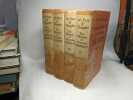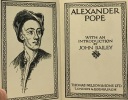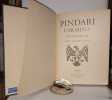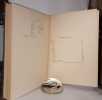13856 books for « alexander »Edit
-
Type
Art print (2)
Book (13838)
Engraving (1)
Magazine (5)
Manuscript (2)
Maps (2)
Music sheets (79)
New book (6)
-
Latest
Last 3 days (290)
Last month (2141)
Last week (175)
-
Language
Dutch (7)
English (28)
French (2692)
German (11)
Greek (2)
Italian (2)
Japanese (1)
Latin (4)
Russian (11188)
-
Century
16th (4)
17th (4)
18th (64)
19th (160)
20th (1213)
21st (233)
-
Countries
Belgium (220)
Brazil (6)
Canada (21)
China (10)
Côte d'Ivoire (3)
Denmark (92)
France (1867)
Germany (4)
Greece (4)
Italy (7)
Netherlands (48)
Switzerland (401)
United Kingdom (15)
United States of America (11237)
-
Syndicate
ALAC (16)
CLAM (20)
CLAQ (3)
ILAB (1271)
NVVA (84)
SLACES (84)
SLAM (952)
SNCAO (1)
Topics
- Actors (7)
- Africa (14)
- American literature (8)
- Archaeology (16)
- Architecture (47)
- Army (7)
- Astronomy (7)
- Belgium (8)
- Bible (12)
- Biography (20)
- Calder alexander (9)
- Children’s books (35)
- China (10)
- China (19)
- Christmas (7)
- Cinema (13)
- Circus (9)
- Civilisation (9)
- Detective novels (12)
- Early printed books (11)
- Economics (9)
- England (11)
- English (53)
- Engravings (10)
- Entomology (9)
- Epistemology (7)
- Ethic (12)
- Fine arts (37)
- First edition (41)
- Flora (7)
- Fox (7)
- Furniture (9)
- Furniture (8)
- Geography (24)
- Germanic languages (76)
- Germany (16)
- Greece (11)
- Greek (8)
- Guide books (8)
- Guittoneau ben (11)
- Helvética (41)
- Hermeticism (8)
- History (173)
- Industrial arts & crafts - fine arts (7)
- Java (7)
- Latin (23)
- Law (14)
- Lernet-holenia alexander (13)
- Linguistics (9)
- Literature (147)
- Magazine (8)
- Mc kee alexander (22)
- Medicine (38)
- Military arts (7)
- Music (16)
- Navy (18)
- Newspapers press (10)
- Painters (6)
- Painting (15)
- Philosophy (35)
- Photography (28)
- Physics (8)
- Poetry (14)
- Policy (8)
- Pope alexander (22)
- Prokofiev (21)
- Psychoanalysis (16)
- Psychology (29)
- Religions (25)
- Review (8)
- Reviews (7)
- Revue de l'art (8)
- Russia (30)
- Sciences (34)
- Scores (98)
- Sculpture (11)
- Shapes & colours (7)
- Silversmith’s trade (7)
- Songs (76)
- Switzerland (33)
- Symbolism (8)
- Tea (65)
- Technology (9)
- Theatre (8)
- Theology (22)
- Translation (11)
- Travel (16)
- United states (11)
- Ussr (13)
- Various (32)
- Walker alexander (10)
- Waltz (19)
- War (57)
- Werth alexander (27)
- Western (12)
- Williams tennessee (8)
- Woods & woods’ price lists (7)
- Youth (9)
- Zoology (8)
Alexander Hamilton: Writings (LOA #129) (Library of America Founders Collection Band 4)
Library of America 2001 1108 pages 12 954x3 302x20 066cm. 2001. Cartonné jaquette. 1108 pages.
Comme neuf avec sa jaquette intérieur propre bonne tenue
Alexander of Aphrodisias: On Aristotle Prior Analytics: 1.8-13 (with 1.17 36b35-37a31) (Ancient Commentators on Aristotle)
BRISTOL CLASSICAL PR 1999 256 pages in8. 1999. Cartonné jaquette. 256 pages.
Très bon état avec sa jaquette
My Past & Thoughts; The Memoirs of Alexander Herzen Vols. 1-4
Chatto & windus 1968 in8. 1968. Cartonné jaquette. 4 volume(s).
livres en bon état intérieurs propres jaquettes défraîchies bords frottés emboîtage défraîchie frotté
Alexander of Aphrodisias: On Aristotle Prior Analytics 1.14-22 (Ancient Commentators on Aristotle)
BRISTOL CLASSICAL PR 1999 2 pages 16 2x2 2x23 8cm. 1999. Relié. 2 pages.
très bon état de conservation intérieur propre bonne tenue 10 dernières pages cornées sur le coin supérieur avec sa jaquette dos insolé
Alexander Pope with an introduction by John Bailey
Nelson & sons 1950 12. 1950. Cartonné. texte en anglais
Etat Correct circa 1950
Le Régiment des Deux-Siciles
Calmann-Lévy 1994 285 pages 18x2 8x11cm. 1994. Broché. 285 pages.
Très Bon Etat intérieur propre bonne tenue
The Reforms of Peter the Great: Progress Through Violence in Russia (New Russian History)
Routledge 1993 344 pages in8. 1993. Broché. 344 pages.
Très Bon Etat de conservation intérieur propre bonne tenue
The gulag archipelago 1918-1956
Fontana 1974 in12. 1974. Broché.
Bon état bonne tenue intérieur propre
What is Communist Anarchism
Dover Publications Inc 2003 333 pages 13 716x2 032x20 828cm. 2003. Broché. 333 pages.
Bon état une ride sur le dos intérieur propre étiquette sur le premier plat
The Art of Rhetoric in the Roman World: A History of Rhetoric: The Art of Rhetoric in the Roman World 300 B.C.-300 A.D
Princeton University Press 1972 301 pages in8. 1972. Broché. 301 pages.
Bon état couverture défraîchie bords un peu frottés intérieur propre
Arguing About Science (Arguing About Philosophy)
Routledge 2012 808 pages 17x4 6x24 4cm. 2012. Broché. 808 pages.
Très bon état intérieur propre bonne tenue légères ternissures sur la tranche
Introduction to Medieval Logic
OXFORD UNIV PR 1993 226 pages 13 97x1 73x21 59cm. 1993. Cartonné jaquette. 226 pages.
Bon Etat jaquette un peu défraîchie dos insolé intérieur propre bonne tenue
Poems of Sophia
Semantron Press 2014 200 pages 15 24x22 86x1 1684cm. 2014. Broché. 200 pages.
Comme neuf
El atraso económico en su perspectiva histórica
Ariel 1968 in8. 1968. Broché jaquette.
livre en bon état intérieur propre jaquette défraîchie abîmée sur son bords supérieur
Europe in the Russian Mirror: Four Lectures in Economic History
Cambridge University Press 1970 in8. 1970. Cartonné.
Bon état avec sa jaquette intérieur propre bonne tenue ex-libris
Continuity in History and Other Essays
Belknap Press 1968 in8. 1968. Cartonné jaquette.
jaquette défraîchie accrocs sur les bords trache ternie présence de quelques notes au stylo ex-libris
El Delincuente y sus jueces desde el punto de vista analitico
Biblioteca nueva 1961 in8. 1961. Broché.
Bon Etat couverture défraîchie bords frottés intérieur propre
Dike Phonou: The Right of Prosecution and Attic Homicide Procedure
Vieweg+Teubner Verlag 1996 145 pages in8. 1996. Cartonné. 145 pages.
Très bon état sans jaquette
La Russie en guerre - T.1/ La patrie en danger + T.2/ De Stalingrad à Berlin
Stock 1965 in8. 1965. Broché. 2 volume(s).
Bon état couvertures défraîchies intérieurs propres
The Holocaust Kingdom - A Memoir
Holt rinehart and winston 1965 in8. 1965. Cartonné.
livre en bon état intérieur propre jaquette défraîchie bords frottés
Gerda ALEXANDER Bennett Lowen Perls Frederick Krippner Rubin Samuels Stanway
Reference : 100133325
(1970)
7 livres collection "Le corps à vivre":Ma Gestalt-thérapie + Le corps retrouvé + Mangez le brut + Je suis bien dans ma peau + Les énergies du corps vivant + Le langage du corps + Amour et orgasme
Tchou 1970 in8. 1970. Broché. 7 volume(s).
circa 1970/80 --- Bon état d'ensemble quelques ternissures par endroits sur les tranches ou dans les plats intérieurs
The Pre-Socratics: A Collection of Critical Essays
Princeton University Press 1994 559 pages 13 8x2 8x21 4cm. 1994. Broché. 559 pages.
Très bon état de conservation intérieur propre bonne tenue
Le Soud-Ouest Africain. La Mission Sacrée
Da Gama 1963 in8. 1963. Cartonné.
Bon état jaquette salie intérieur propre livre en bon état
Pindari carmina cum fragmentis
Basilium blackwell 1952 402 pages in-8. 1952. Relié. 402 pages.
Reliure toile bleue bordure frottée. Intérieur bon
Litauisch-Deutsches Wörterbuch Volumes I & II
Vandenhoek & Ruprecht 1970 1632 pages in-8. 1970. Relié avec jacquette. 2 volume(s). 1632 pages.
Bon état légère usure de la couverture ( jaquette ) intérieur très bon
 Write to the booksellers
Write to the booksellers





































































